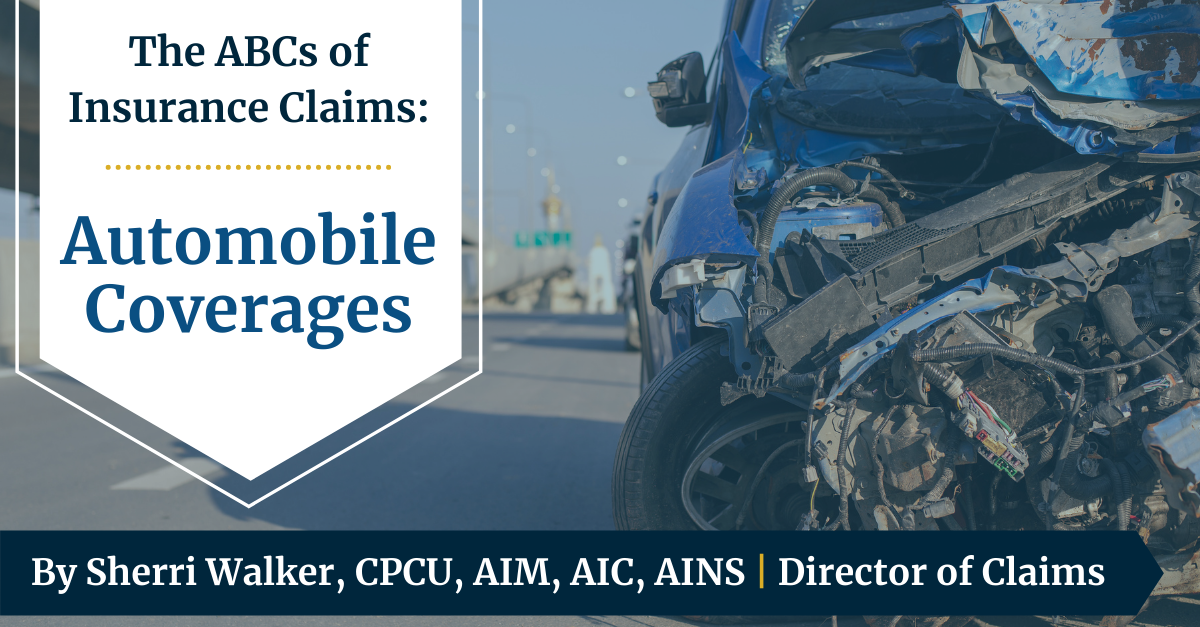Welcome to the ABCs of Insurance claims. Over the next few months, Sherri Walker, Sentinel’s Director of Claims will address an aspect of claims handling for every letter of the alphabet to help provide a better understanding of the claims process.
A is for Automobile Coverages.
In any Automobile Policy, business or personal, there are varying types and levels of automobile coverages available, and these coverages benefit different parties. Your policy is broken down into Third-Party Coverages for damages to others, and First-Party Coverages for damage to yourself and your property.
Third-Party Automobile Coverages
Third-Party coverages are liability coverages, which are typically required by the licensing state in which the vehicle is registered. While different states have their requirements, North Carolina requires a minimum coverage level referred to as “30/60/25”: $30,000 of bodily injury coverage per person, up to a $60,000 per occurrence maximum, and $25,000 of Property Damage. This would cover damages to another person (Third-Party) for which you are legally liable in the event of an accident – for their injuries, cost of repairs to a vehicle or other damaged property, rental for the time their vehicle is out of commission, or potentially the total loss of that vehicle. While 30/60/25 is the state requirement, these amounts are often insufficient to fully cover the costs of severe accidents. Your insurance consultant is always happy to discuss your limits, and whether they should be increased to protect you and your assets if an accident occurs over those amounts.
Standard liability limits on commercial automobile policies are $1,000,000 and oftentimes an umbrella or excess liability is also carried on larger fleets. On personal auto policies, standard limits are often quoted and bound above the state minimum requirements at $100,00/$300,000/$100,000 with the option to increase to $250,000/$500,000/$250,000 required if a personal umbrella or excess is carried.
First-Party Automobile Coverages
Regarding First-Party coverages, most people have heard the term “full coverage,” though that is a bit of a misnomer. There are always things in an insurance policy that will not be covered, as they are excluded under the policy. The physical damage coverages that most people reference under “full coverage” are Collision and Comprehensive.
Collision coverage applies to the impact or upset of your covered vehicle with an object or another vehicle. This typically encompasses car accidents regardless of the number of vehicles involved. This could include a single car hitting a stationary object such as a mailbox, tree, or pole, or even resulting in damage from simply striking a pothole in the roadway. Collision coverage carries a deductible, most commonly in the amounts of $250, $500, or $1000 per claim.
Comprehensive includes damages that are not related to a collision – such as animal damage (hitting a deer), fire, windshields, theft & vandalism. Comprehensive coverage can also carry a deductible but sometimes is written on a $0 deductible basis. Your insurance advisor can discuss the best options for those coverages, as well as additional First-Party coverages that can be added to your policy by endorsements, such as Rental Expense, Replacement Cost, Medical Payments, and Towing & Labor.
Additional Automobile Coverages
Other coverages to discuss include Uninsured and Underinsured Motorist coverages. Uninsured coverage applies when a vehicle with no insurance is involved in a collision with an insured party. For this coverage to apply for Property Damage, there must be enough information on the vehicle to determine that it is not insured, and enough information to prove that the uninsured motorist was at fault for the accident. This means that if there is no information on a vehicle, as in a hit & run incident, there is no coverage available for damage to your vehicle other than Collision coverage. Bodily Injury coverage requires only that the other driver be at fault and can be triggered even without concrete information on that vehicle. Uninsured Motorists’ coverage carries a standard $100 Deductible.
For bodily injuries, Underinsured coverage is triggered when an at-fault driver does not have enough limits to pay for the accident. As we discussed above, the state minimums of liability coverage may not be sufficient to cover a severe accident. If you carry higher than the state minimums and are involved in an accident with someone who only carries the minimum required limits, then Underinsured Motorists coverage can cover the “gap” between the responsible party’s minimum and your limits. For example, if you have 100/300 Bodily Injury limits, and someone with 30/60 limits is at fault for your injuries and they exceed that $30,000 of coverage, your Underinsured Motorist coverage would provide up to an additional $70,000 of coverage, to cover the gap between the at-fault party’s and your limits.
Safeguarding Your Success
While these automobile coverages may seem daunting, rest assured that Sentinel is always ready to review the coverages you have in place and provide advice, consultation, and guidance on whether they are sufficient. Insurance can be a maze, but with the amazing team of professionals at Sentinel, you can rest assured that there will always be assistance to safeguard you along the way.


